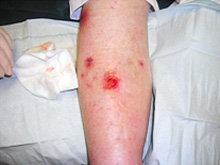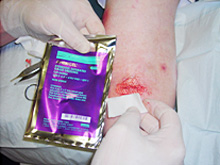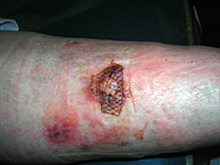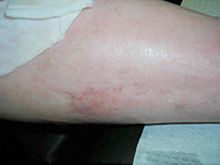The efficacy of bioengineered alternative tissue (BAT) for lower extremity ulcers (diabetic and non-diabetic) is well described in the literature. These tissues include allograft, xenografts and manufactured/engineered biologic products. However, the primary goal in using a BAT is to stimulate the granulation of a chronic wound and augment the wound’s intrinsic healing pathway, thus creating a bridge to epithelialization of the wound.
Instead of applying a plain dry nonadherent pad as the primary dressing, it was decided to use an advanced wound care product, AmeriGel® Hydrogel Saturated Gauze dressing containing a polyethylene glycol (PEG) base. The PEG base is slow to evaporate, as compared to common hydrogels containing water, saline or glycerin.
 |
|
 |
1A. A 63-year-old female with diabetes and rheumatoid arthritis presented with a chronic venous ulceration (2 cm X 2.6 cm) to the dorsal aspect of the right leg. |
|
1B. The wound had been present for over two months
despite application of compression therapy and topical agents. The GraftJacket® was sutured to the wound site followed by an AmeriGel® Hydrogel Saturated Gauze Dressing placed directly over the BAT site.
|
 |
|
 |
1C. A 4" X 4" fluff and an elastic bandage were applied over the AmeriGel® Hydrogel Saturated Gauze Dressing for moderate compression. After one week, the dressing was changed and was thereafter changed daily with AmeriGel® Hydrogel Saturated Gauze Dressing at home by the patient. The secondary dressing was dry sterile gauze.
|
1D. Four weeks after application of the GraftJacket®, the wound site (along with all of the surrounding erythema) was completely resolved. It was noted that the AmeriGel® Hydrogel Saturated Gauze Dressing facilitated significant reduction of the erythema that had been persistent around the wound. |
Effective management of lower extremity ulcerations using a bioengineered alternative tissue with AmeriGel® Saturated Gauze Dressing as the primary dressing demonstrates complete incorporation of the BAT without desiccation and wound healing. No additional BAT applications were necessary to heal this ulceration.